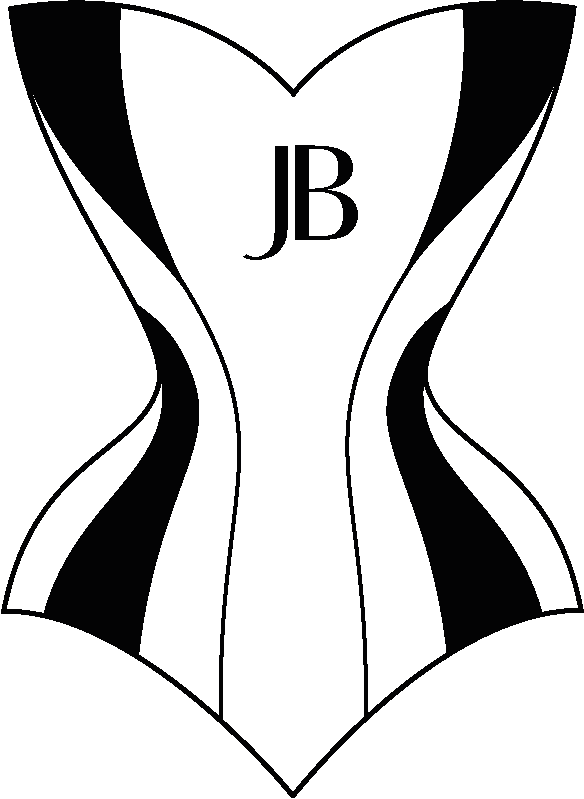" I am really impressed by its fit. It's the most expensive corset in my collection so far and every (extra) penny is worth it! "
Please follow these guidelines to find out your ideal corset size
Tie a ribbon or elastic around your natural waist. This is the squishy area between the bottom of your lowest rib, and the top of your hip bone. If you bend your torso to one side, it will usually be the place where a natural crease forms. All measurements in corsetry are reference from this point at the waist. When you have tied the ribbon around your waist, measure the circumference with a tape measure - the tape measure should be snug, not loose and with no room left for ease.
After measuring the waist, measure 4 inches down for the upper hip and/or 8 inches down from the waist to the lower hip. Your ribbon will ensure that your waist reference remains constant. Pivot the measuring tape and measure the circumference of your hip at these points. This are the hip measurements that you will need for the size chart below.
Now apply your measurements to the chart below to determine which size will best fit you. All measurements are in inches.
SOME NOTES ON HOW STANDARD SIZING WORKS
Standard sizing for clothes was discovered by the guild of military tailors at the turn of the century. They discovered a system whereby if a person had a certain chest size, then they would likely have a certain waist size, and a certain corresponding hip size. Most people fall into a standard size chart even though many high street sizing systems also cater for different demographics (old/young/middle aged etc.,). Standard sizing does not allow for individual figure anomalies any more than high street clothing does. For example if you have an unusually long torso where high street sizes finish below the bust, then a standard size corset may not fit you or may be less 'modest' than expected. New standard size made to order corsets are returnable for this reason, samples and sale items are not.
The chart above is a standard, ready to wear chart which has been tried and tested over many years. Ready to ship corsets are made to this standard chart.
Corsets made to this standard size chart will have a built in lacing gap at the back of the corset of 2 inches - this is to allow for different weight distribution of each body and weight fluctuations of individuals.
This size chart has been tested on hundreds of women over nearly 15 years and has an extremely wide range of fit. There are as many corset measurement systems as there are corset makers. Each maker has their own formula and method of fit. A good corset fit depends on a combination of distribution, balance and pressure. My system is the result of many years of intense personal study through making corsets for clients and teaching corsetry to all shapes and sizes of women over a number of years.
All bodies are different - You can have two bodies of identical size, which behave differently in a corset. Having the exact horizontal dimensions of a corset will not determine a good or bad fit because the fit depends upon many more factors than simply measurements. This does not mean that any corset will fit, it means that if you pick your size carefully according to the size chart, having followed the instructions given, you should be able to determine the best corset size for you and that corset should give a very good fit. Whenever you purchase a corset therefore, please trust the reputation, experience and expertise of the corsetiere.
Our RTW corsets and samples are made on the curvy side for a natural female physiology. An underbust may give a passable fit to a male physique but an overbust will not. I have many very happy male clients and am always happy to customise the RTW corsets for male figures, or work on a bespoke basis (always best).
How to care for your corset
If you are not used to wearing corsets, you may need to undergo a 'breaking in period' - just like breaking in a pair of high heel shoes. When you first wear a brand new corset it will feel quite rigid and the gap at the back will be at maximum width. Over wear, the corset fabric will soften and it will mould to your body until eventually it will feel more like a second skin or outer skeleton - just as our favourite shoes soon feel like 'slippers' to wear. New corset wearers should lace moderately at first and wear only for short time periods. Do not lace it tightly straight away as this may cause undue stress on your body.
During the process of getting to know your corset, the gap at the centre back will narrow and depending upon how 'squishy' your body is, you may be able to close the corset eventually. This is not guaranteed and the corset will still give the shape it was intended to give. However, at this stage, when your body has got so used to the corset, it may be possible to size down the waist if you wish to start waist training. Sizing down does not mean you buy a smaller size corset because your ribcage and hips will not have changed in size. You therefore require a bespoke fit corset to continue waist training if required.
Cleaning your corset
Corsets can be dry cleaned. Please do not wash them with water. This is because metal components may rust when exposed to water. To keep your corset as clean as possible, wear it corset with a light vest top or corset liner underneath to keep it from getting dirty, and air it after use by hanging it out for a little while.


